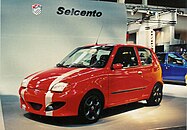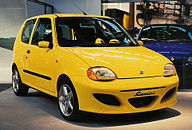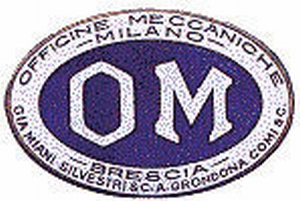
Officine Meccaniche or OM was an Italian car and truck manufacturing company. It was founded in 1899 in Milan as Società Anonima Officine Meccaniche to manufacture railway rolling stock and car production began in 1918. It disappeared as such in 1975, subsumed into Iveco, but still exists as a forklift builder.

The Fiat 124 is a small family car manufactured and marketed by Italian company Fiat between 1966 and 1974. The saloon superseded the Fiat 1300 and was the basis for several variants including a station wagon, a four-seater coupé, a two-seater convertible and a lengthened and more luxurious version, the 125, launched in early 1967.

The Fiat 500 is a rear-engined, four-seat, small city car that was manufactured and marketed by Fiat Automobiles from 1957 until 1975 over a single generation in two-door saloon and two-door station wagon bodystyles.

The Fiat Panda is a city car manufactured and marketed by Fiat since 1980, currently in its third generation.
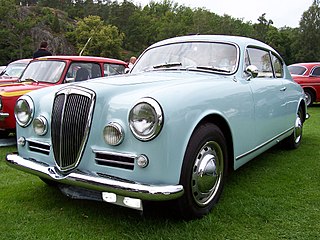
A grand tourer (GT) is a type of car that is designed for high speed and long-distance driving, due to a combination of performance and luxury attributes. The most common format is a front-engine, rear-wheel-drive two-door coupé with either a two-seat or a 2+2 arrangement. Grand tourers are most often the coupé derivative of luxury saloons or sedans.

The Fiat 600 is a rear-engine, water-cooled city car, manufactured and marketed by Fiat from 1955 to 1969 — offered in two-door fastback sedan and four-door Multipla mini MPV body styles.

The Auto Avio Costruzioni 815 was the first car to be fully designed and built by Enzo Ferrari. Legal issues with former associates Alfa Romeo prevented Ferrari from creating the Ferrari marque. The 815 raced at the 1940 Brescia Grand Prix, where both entries failed to finish due to engine problems. One of the cars was later scrapped, while the other is currently in a car collection in Italy.
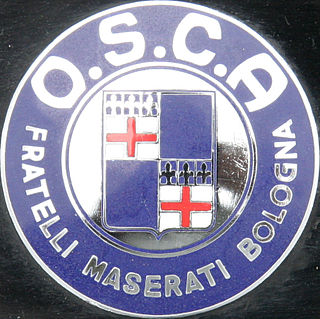
O.S.C.A. was an Italian manufacturer of racing and sports cars established 1947 in San Lazzaro di Savena, Bologna, by the Maserati brothers, and closed down in 1967. The company name is usually written OSCA or Osca.
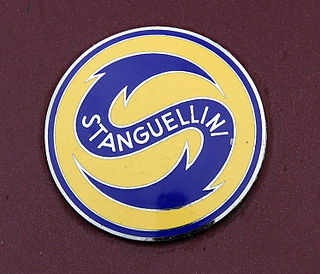
Automobili Stanguellini was an Italian maker of small sports cars, based in Modena and founded by Vittorio Stanguellini; it was most active between 1946 and 1960. They continued to produce competition cars until 1981, when Vittorio Stanguellini died; thenceforth, the company devoted to vintage cars.

Siata was an Italian car tuning shop and manufacturer founded in 1926 by amateur race car driver Giorgio Ambrosini.

Bandini Automobili was an Italian automobile manufacturer operating between 1946 and 1992. It was named after its founder Ilario Bandini.
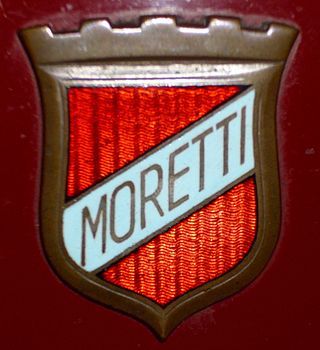
Moretti S.p.A. is a former Italian automobile manufacturer. It was founded in 1925 and ceased automobile production in December 1989. Today, many of its sports car models can still be found at various European auto shows. Moretti Motors produced a variety of models at various times including motorcycles, microcars, and several commercial vehicles.

Enrico Nardi was an Italian racing car driver and designer.
The Turin Motor Show was an auto show held annually in Turin, Italy. The first official show took place between 21 and 24 April 1900, at the Castle of Valentino, becoming a permanent fixture in Turin from 1938 having shared it with Milan and Rome until that time. From 1972, the show was held biannually and in 1984, it moved into Fiat's shuttered Lingotto factory.

Fiat Automobiles S.p.A. is an Italian automobile manufacturer, formerly part of Fiat Chrysler Automobiles, and since 2021 a subsidiary of Stellantis through its Italian division Stellantis Italy. Fiat Automobiles was formed in January 2007 when Fiat S.p.A. reorganized its automobile business, and traces its history back to 1899 when the first Fiat automobile, the Fiat 4 HP, was produced.
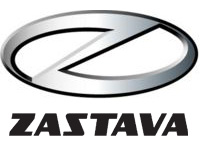
Zastava Automobiles was a Serbian international car manufacturer, a subsidiary of Group Zastava Vehicles which went bankrupt in May 2017.

The Lombardi Grand Prix is a small, rear-engined sports car on Fiat 850 underpinnings. It was developed by the Carrozzeria Francis Lombardi with an in-house design by Giuseppe Rinaldi. The car was built from 1968 until 1972 and was also marketed as the OTAS 820, as a Giannini, and as the Abarth Grand Prix and Scorpione. It was first shown in March 1968, at the Geneva Motor Show. The design had a Kammback rear and a very low nose with flip-up headlights, and a large single windshield wiper. The pop-up headlights were electrically powered. The bodywork was all steel, except the rear panel. The design was originally shown as a prototype based on the front-wheel drive Autobianchi A112, and was adapted by Lombardi for the 850 sedan's floorpan. At Turin 1969 a targa version was also shown; called the "Monza", this open model has a rollover bar. At least two were built but it is unknown whether any were sold.

The Carrozzeria Francis Lombardi was founded in 1947 in Vercelli, Italy, by noted pilot Carlo "Francis" Lombardi. They originally engaged in some aeronautical design, but this soon ended. Their most famous car was the Lombardi Grand Prix, which was also marketed under a variety of other names such as O.T.A.S. and Abarth. The company was closed in 1973.

Stellantis Poland is an automobile factory belonging to Stellantis formed on May 28, 1992, after Fiat acquired Fabryka Samochodów Małolitrażowych (FSM) in Bielsko-Biała and Tychy. At that time, Fiat Auto took over 90% of the company's shares. The takeover of FSM by Fiat has been considered hostile and controversial. The plant has been part of Stellantis since 2021, following the merger of FCA and PSA Group. As of 2020, the facility had 2,500 employees.

The OSCA MT4, also spelled the O.S.C.A. MT4 or Osca MT4, is an Italian sports car prototype, designed, developed, and made by Officine Specializzata Costruzioni Automobili, between 1948 and 1956, but was raced and used in active competition until 1966.





